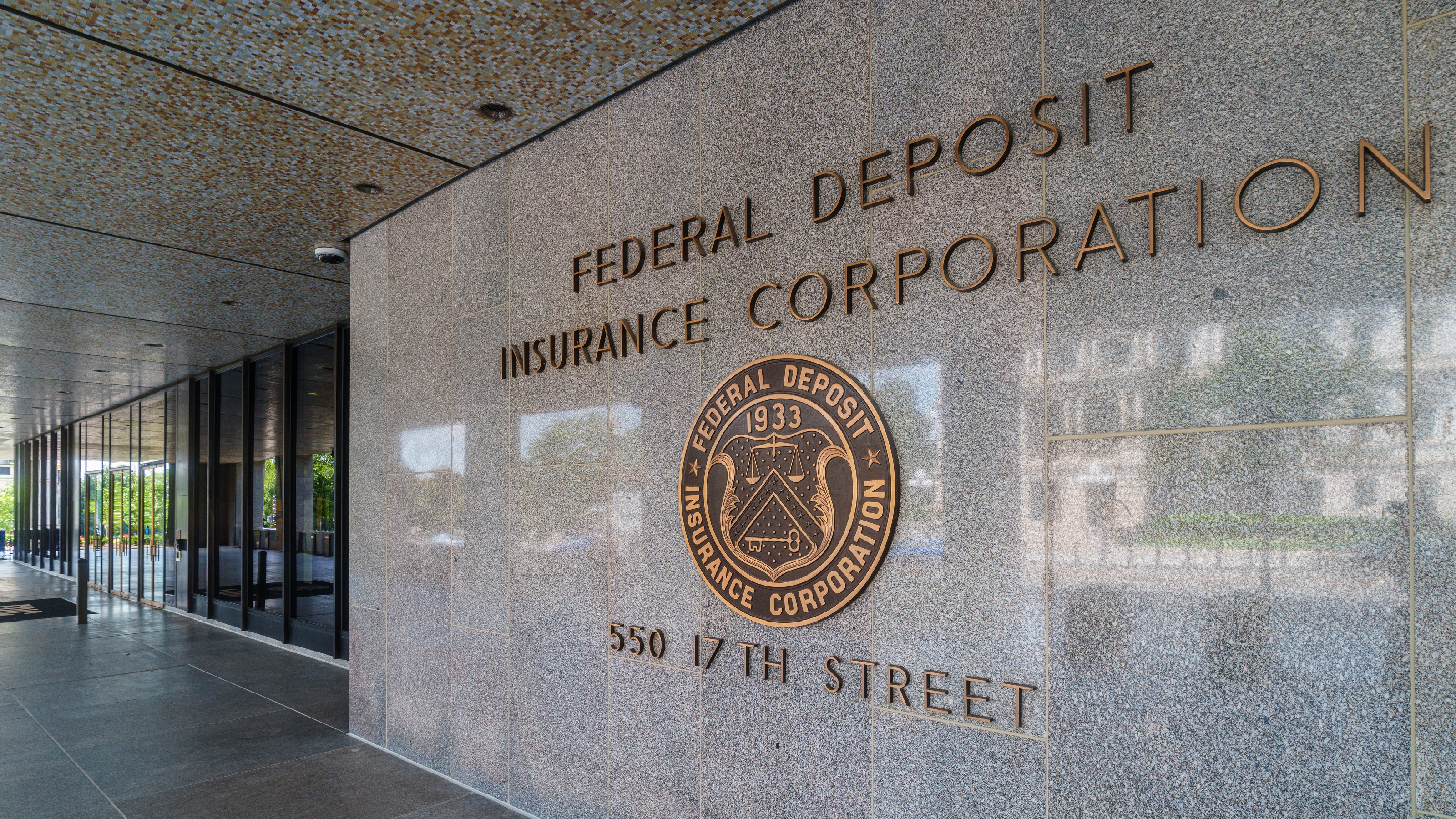The FDIC Is From the Government and Really Is Here to Help
The FDIC has spent more than nine decades in action, so let's take a look at what it does and why it's so important for consumers.


There are a lot of people — especially older Americans — who do not trust the stock market or simply do not want to have their retirement funds at risk of the kinds of losses that can hit the markets. And so they place their money in various accounts at banks insured by the FDIC, the Federal Deposit Insurance Corporation.
This incredibly important, independent agency of the United States government celebrated its 90th anniversary last year, protecting bank depositors against the loss of their insured funds in the event their bank or savings association fails.
It is important to understand how the FDIC has proven itself critical to the stability of our banking system and — no exaggeration — our financial system.
From just $107.88 $24.99 for Kiplinger Personal Finance
Become a smarter, better informed investor. Subscribe from just $107.88 $24.99, plus get up to 4 Special Issues

Sign up for Kiplinger’s Free Newsletters
Profit and prosper with the best of expert advice on investing, taxes, retirement, personal finance and more - straight to your e-mail.
Profit and prosper with the best of expert advice - straight to your e-mail.
Let’s take a look at why and when the FDIC was established. Two words help explain why: bank run.
What is a bank run?
A bank run occurs when a large group of depositors — fearing their bank will become insolvent — withdraw, or attempt to withdraw, their money at the same time. We’ve all seen photos of thousands of people in long lines, hoping to get their money out of banks during the Depression in the 1930s and the Great Recession in 2008.
As only about 13% of a bank’s assets are in cash, that can quickly be depleted. If the institution can’t sell assets quickly enough to meet depositors’ deposit demands, failure can result. During the Depression, more than 9,000 banks failed, replacing many families’ life savings with poverty and fear. Billions of dollars evaporated.
There was no national deposit insurance system in the U.S. at that time.
Recognizing the need to protect bank depositors, President Franklin Roosevelt signed the Banking Act of 1933 (aka the Glass-Steagall Act) into law, creating the FDIC. Funded not by taxpayers, but through assessments on banks themselves, the FDIC’s mission is to “maintain stability and public confidence in our nation’s financial system.”
How does the FDIC work? What is and isn’t covered?
Unlike other types of insurance, where you have to pursue and pay for coverage, the simple act of opening a deposit account at an FDIC-insured bank or financial institution automatically covers your deposits.
Here are examples of deposit products insured by the FDIC:
- Checking and savings accounts
- Certificates of deposit (CDs)
- Money market deposit accounts
- Prepaid cards, cashier’s checks, money orders and other official items issued by a bank
- Negotiable order of withdrawal (NOW) accounts
However, the following are not insured, even if purchased through an FDIC-insured bank:
- Stock, bond and mutual fund investments
- Crypto assets
- Life insurance policies
- Annuities
- U.S. Treasury bills, bonds or notes
- Municipal securities.
- Contents of safe-deposit boxes
What are the limits of coverage?
Of course, virtually every type of insurance has limits of coverage (how much will be paid in the event of a covered loss). To learn how this works with insured bank products, I spoke with Washington, D.C.-based Martin Becker, chief of Deposit Insurance at the FDIC.
“Deposits are insured for up to $250,000 per depositor, per account ownership category, per FDIC-insured bank,” Becker points out. “And the limits of coverage increase by $250,000 with additional beneficiaries on the account, up to a maximum of $1.25 million under the trust category, at one institution. Recently, we have simplified the rules for trusts. For your readers with large amounts of money wanting FDIC protection, this is certainly possible if the accounts are correctly set up. The FDIC has an online tool, EDIE, that has been used by millions of consumers to determine their coverage. I also recommend spending time on (the area of) our website that explains FDIC deposit insurance ownership categories.
“Additionally, we have customer service representatives who are able to answer your questions. Just call 877-275-3342 (877-ASK-FDIC).”
Recent FDIC coverage changes limit the number of beneficiaries
Timing is everything, and the day after my interview with Becker, 89-year-old “Martha” phoned my office, upset. “Mr. Beaver,” she said, “I have a great deal of money in a bank savings account with eight family members as beneficiaries for when I die. A financial adviser I met last year just called and told me that the FDIC coverages had changed and I needed to meet with him to discuss placing some money in stock market investments. Is that correct?”
“Martha, what you were told is nonsense! Yes, the FDIC did make some changes, but nothing requires you to get into the stock market. Each (trust) account owner is insured up to $250,000 for each beneficiary, with a maximum of five beneficiaries and a total of $1.25 million insured, per financial institution.”
I related to Martha what Becker advised in this situation. “Simply open an additional (trust) account at a different FDIC-insured bank, or at several FDIC-insured banks,” if her deposits exceed $1.25 million. For example, she could split her eight beneficiaries among different FDIC-insured banks, ensuring that each trust account does not exceed $1.25 million.
The people at the FDIC really are from the government and are here to help.
Dennis Beaver practices law in Bakersfield, Calif., and welcomes comments and questions from readers, which may be faxed to (661) 323-7993, or e-mailed to Lagombeaver1@gmail.com. And be sure to visit dennisbeaver.com.
Related Content
- How to Get Employees to Tell You Like It Is
- If It Looks Like Elder Financial Abuse, It May Be Just That
- I Listened to a Pitch for a Possible Bitcoin Scam So You Don’t Have To
- Zombie Mortgages Come Back to Haunt Property Owners
- Six Things Not to Do if You Want to Resolve a Conflict
Profit and prosper with the best of Kiplinger's advice on investing, taxes, retirement, personal finance and much more. Delivered daily. Enter your email in the box and click Sign Me Up.

After attending Loyola University School of Law, H. Dennis Beaver joined California's Kern County District Attorney's Office, where he established a Consumer Fraud section. He is in the general practice of law and writes a syndicated newspaper column, "You and the Law." Through his column, he offers readers in need of down-to-earth advice his help free of charge. "I know it sounds corny, but I just love to be able to use my education and experience to help, simply to help. When a reader contacts me, it is a gift."
-
 States That Tax Social Security Benefits in 2026
States That Tax Social Security Benefits in 2026Retirement Tax Not all retirees who live in states that tax Social Security benefits have to pay state income taxes. Will your benefits be taxed?
-
 QUIZ: What Type Of Retirement Spender Are You?
QUIZ: What Type Of Retirement Spender Are You?Quiz What is your retirement spending style? Find out with this quick quiz.
-
 How to Avoid the Financial Quicksand of Early Retirement Losses
How to Avoid the Financial Quicksand of Early Retirement LossesSequence of returns — experiencing losses early on — can quickly deplete your savings, highlighting the need for strategies that prioritize income stability.
-
 QUIZ: What Type Of Retirement Spender Are You?
QUIZ: What Type Of Retirement Spender Are You?Quiz What is your retirement spending style? Find out with this quick quiz.
-
 This Is How Early Retirement Losses Can Dump You Into Financial Quicksand (Plus, Tips to Stay on Solid Ground)
This Is How Early Retirement Losses Can Dump You Into Financial Quicksand (Plus, Tips to Stay on Solid Ground)Sequence of returns — experiencing losses early on — can quickly deplete your savings, highlighting the need for strategies that prioritize income stability.
-
 How an Elder Law Attorney Can Help Protect Your Aging Parents From Financial Mistakes
How an Elder Law Attorney Can Help Protect Your Aging Parents From Financial MistakesIf you are worried about older family members or friends whose financial judgment is raising red flags, help is out there — from an elder law attorney.
-
 Q4 2025 Post-Mortem From an Investment Adviser: A Year of Resilience as Gold Shines and the U.S. Dollar Dives
Q4 2025 Post-Mortem From an Investment Adviser: A Year of Resilience as Gold Shines and the U.S. Dollar DivesFinancial pro Prem Patel shares his take on how markets performed in the fourth quarter of 2025, with an eye toward what investors should keep in mind for 2026.
-
 'Donroe Doctrine' Pumps Dow 594 Points: Stock Market Today
'Donroe Doctrine' Pumps Dow 594 Points: Stock Market TodayThe S&P 500 rallied but failed to turn the "Santa Claus Rally" indicator positive for 2026.
-
 Is Your Emergency Fund Running Low? Here's How to Bulk It Back Up
Is Your Emergency Fund Running Low? Here's How to Bulk It Back UpIf you're struggling right now, you're not alone. Here's how you can identify financial issues, implement a budget and prioritize rebuilding your emergency fund.
-
 An Expert Guide to How All-Assets Planning Offers a Better Retirement
An Expert Guide to How All-Assets Planning Offers a Better RetirementAn "all-asset" strategy would integrate housing wealth and annuities with traditional investments to generate more income and liquid savings for retirees.
-
 Forget FIRE: Why ‘FILE’ Is the Smarter Move for Child-Free DINKs
Forget FIRE: Why ‘FILE’ Is the Smarter Move for Child-Free DINKsHow shifting from "Retiring Early" to "Living Early" allows child-free adults to enjoy their wealth while they’re still young enough to use it.